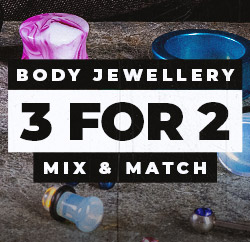Medi-Daith Piercing FAQs
Every single Medi-Daith FAQ you can think of answered in-depth and at length by LMC's Dr Chris Blatchley.
Information Provided by Dr Chris Blatchley
Can Blue Banana piercers give medical advice about my migraine headaches?
Blue Banana piercers are expert piercers, but they are not medically trained and cannot give specific medical advice about your migraine headaches. If you need medical advice, this should always come from your GP.
Do I need a letter from my doctor?
- Most people have had their migraine headaches for years, and may be finding that treatments from their doctor are not controlling them. If you have already visited your GP about your headaches, then the simple answer is no you don't need to see anyone before arranging to have a Medi-Daith with Blue Banana.
- Very rarely, headaches are caused by another illness. If your headaches have started recently, or have changed in nature we always recommend that you contact your GP first. This is simply to ensure there are no other underlying causes.
- If you are worried about your headaches, then you should always see your GP to discuss them.
What is the evidence that a Medi-Daith can affect migraine headaches?
- The Daith Piercing was first invented in 1992 as a cosmetic piercing, but some people soon began to report an unexpected improvement in their migraine headaches. However, there were also people with migraine headaches who found no change, so many people were sceptical of the effects. News on Daith for migraine headaches went viral on social media in 2016, and since then many tens of 1000s have had one, many reporting great reduction in both severity and frequency of their migraine headaches.
- Most doctors still find it difficult to accept there might be an effect because there has been no published research to medical standards, and the standard medical response is to believe that any effect must be a placebo response (in the mind). Our research is to explore whether there is an effect beyond placebo. We believe there is, but we also believe there should be medical research to confirm whether this is true.
- By chance, the Daith passes through the only place on the body that is innervated by the vagus nerve, a calming nerve that controls many bodily functions. Electrical stimulation of the vagus is a medically accepted treatment for both migraine headaches and epilepsy.
- Through the use of specialist brain scans, there is scientific evidence that stimulating the skin in the same place as a Daith piercing produces changes in brain activity. A Daith piercing does not use any electrical stimulation but it heals very slowly. It is entirely reasonable to suggest that this irritation will produce similar changes in brain activity, as seen with electrical stimulation. Our research shows that temporarily stimulating the same area with a fine needle produces a temporary effect on migraine headache symptoms, and this disappears when the needle is removed. As yet, this brain scan research has not been performed on people with a Daith, and this is something LMC plan to do in the next few months.
- It is important to remember that a Medi-Daith does not work for everybody, and some get no response at all.
Are there any medical conditions that might stop me having a Medi-Daith?
- If you have a chronic skin condition such as Eczema, Psoriasis or Keloid scarring then this may need medical assessment before you have a Medi-Daith piercing. As a daith piercing is through cartilage it may heal very slowly. In fact, this slow healing may well be part of the reason why it can work, because the irritation is thought to stimulate the Vagus Nerve
- If you have Eczema, Psoriasis or other similar skin conditions that have affected your ears then we would not recommend a Medi-Daith piercing.
- If you have keloid scars on any other parts of your body then any type of piercing, including a Medi-Daith Piercing, is not recommended because the chance of developing a keloid on your ear is too high.
How long can the effect of a Medi-Daith last?
- In our initial research 80% of migraine headache sufferers reported an immediate improvement to a Medi-Daith and 40% found after 12 months that they still had an excellent improvement (or that their migraine headaches had stopped) even for those who were seriously affected by their migraine headaches that all other treatments have failed.
- When the effect of a Medi-Daith wears off, it appears it is possible to repeat the piercing to restart the effect.
- If a Daith has to be temporarily removed (e.g. for a brain scan), then the effect appears to stop while the piercing is out. Understandably, recipients reporting an improvement are not keen to test this by unnecessarily having their piercing removed.
- It is important to remember that a Medi-Daith does not work for everybody, and some get no response at all. At present we don't understand why, but we hope that our ongoing research with Blue Banana will help us to understand this better.
Is it painful having a Medi-Daith?
Understandably people often ask this! Perhaps surprisingly, many people say they hardly felt a thing. Most migraine headache sufferers will say that the pain is only momentary and is not as bad as the pain of a migraine headache.
What will happen at my piercing appointment? The appointment takes about 30 minutes. Please arrive 10-15 mins early so we can record some basic information about your migraine headaches before we start.
The piercing itself is very quick but the preparation takes longer than a simple cosmetic piercing because we have to spend time measuring the exact place to pierce. This can't be hurried.
Is a Medi-Daith suitable for my particular migraine headaches?
- Migraine headaches are usually described by the symptoms you have, and not their causes. Migraine headaches affect the whole of the brain causing a general hyper-excitability of the nerve cells. However, some areas are more excitable than others. The specific areas most affected vary from person to person, and this can produce different symptoms in different people. It is more useful to think of the brain as having a faulty fire alarm panel that sets off the siren too easily. A Medi-Daith piercing is thought to work by stimulating the vagus nerve, one of the control nerves that can decrease the hyper-excitability in the brain's nerve cells.
- The presence of marked visual symptoms seems to suggest whether a Medi-Daith might work for you. During a migraine headache, these symptoms present themselves as a dislike of bright or flickering lights, or difficulty looking at strong patterns of dark and light lines.
- At present, we don't have specific evidence for rare migraine headaches such as Hemiplegic migraine headache. However, our general experience suggests that a Medi-Daith may help by cutting down the frequency and severity because the underlying brain process in migraine headaches is hyper-excitability of nerve cells throughout the brain.
Should I stop my migraine headache medication after a Medi-Daith?
- You should not stop taking preventative drugs for your migraine headaches (such as amitriptyline or propranolol) after your Medi-Daith Piercing. It may be possible to tail them off slowly after your Medi-Daith has stabilised, but you should always ask your doctor before you do. We strongly recommend that you continue taking them at the same dose for at least a month before you try reducing them.
- 'Rescue' drugs such as triptans and painkillers are only taken while you're having an attack. You will naturally reduce taking them as the frequency and severity of your attacks begin to change.
Will I only need a Medi-Daith in one ear or will both ears be better?
- We suggest starting with a Medi-Daith in one ear, usually the side that you get most migraine headaches on. You may find that this is sufficient for you to be in control of your migraine headaches (instead of them controlling you!).
- If you are getting some improvements in your migraine headaches, but this isn't enough, then you can always get the other Daith pierced later. Our online surveys of several thousand migraine headache sufferers with a Daith piercing report that two Daith piercings can work better than one, presumably because both sides of the brain will be stimulated through both vagus nerves. Overall, this should also increase the general level of stimulation. We will soon be doing other research at LMC to measure the level of brain stimulation using specialist brain scans.
- We don't generally recommend having both sides done on the same day because it is better to give the first one time settle before you have the second.
Would I have to have my Medi-Daith removed if I need a brain scan for my migraine headaches?
- You cannot have an MRI scan if you have implants made of surgical steel (including Daith piercing jewellery), because the strong magnetic fields in the scanner cause the piercing to heat up. This doesn't happen with titanium, which is why we only use 100% titanium for Medi-Daith piercings, and recommend that if you change the jewellery later then you make sure it is not made of surgical steel.
- If you are due to have an MRI scan on any part of your body then you should contact the hospital before the appointment and explain that you have a 100% titanium piercing in your ear. Generally they will be happy for you to keep the piercing in because they can check with a magnet that the piercing is MRI safe. Unlike surgical steel, titanium is not magnetic.
- If for a special reason the hospital does require the piecing to be removed, then a titanium Daith piercing can be temporarily replaced with a plastic one. Plastic is not generally used for Daith piercings because it is too fragile and can break easily and Blue Banana can arrange this for a small charge. It is an excellent opportunity to change to a new style of jewellery.
Is a Medi-Daith good for children and adolescents?
- Fortunately, migraine headaches are uncommon in young children. They can be very distressing for parents too when they occur. Younger children suffering from migraine headaches may well be under the care of a specialist doctor. Migraine headaches get much more common in adolescence, about the time of puberty and in late teens, especially in girls, when they can often be associated with periods. A Daith can be remarkably effective in teenagers, even in those who are suffering badly with their migraine headaches.
- The minimum age for a Medi-Daith at Blue Banana is 13. Blue Banana have important rules about consent from a parent or legal guardian for those under 18 (ask in-store for details).
- See the section below about asking the school first before you have one.
Iâm worried about getting an infection around my Medi-Daith.
- As mentioned above, daith piercings are through cartilage, so can take a long time to heal. This is true for most ear piercings, except for common ear lobe piercings, where the piercing doesn't pass through cartilage. Mild infections are not uncommon, and can generally be avoided with an effective aftercare routine that includes cleaning the piercing with salt water. Your Blue Banana piercer will explain this when you have your piercing
- On some occasions, you might need antibiotics from your GP to assist with infections. On rare occasions you may have to have the piercing removed. If you have any concerns after your Daith, you should always speak to your Blue Banana piercer, who will be happy to assist you.
Can I wear hearing aids/ear buds/stethoscopes with a Medi-Daith?
Since one end of the piercing is in the ear canal, it is generally difficult to wear hearing aids on the same side of the piercing. If you like listening to music through Ear Buds, then excellent small over-ear headphones are freely available. If you use a stethoscope at work then specialist electronic stethoscopes with headphones are available too.
What about a Medi-Daith at work?
There are two potential problems you may have at work:-
- Some jobs may have rules about wearing jewellery at work. Having said this, there are many employers who will not have heard of a Medi-Daith for Migraine headaches, so the best plan is to speak to your employer before you have a Daith. If your employer is already aware of your migraine headaches, they may be willing to make allowances in order to help you try and alleviate symptoms.
- You should consider that there may be Health & Safety reasons related to the type of work that you do (e.g. on active service in the Armed Forces). It is easier and better to go and discuss your plans with your manager first.
What about a Medi-Daith at school?
- Similar rules apply in the school setting. However we strongly advise that you discuss your Medi-Daith piercing plans before you get pierced. If your school is aware of your migraine headaches and the effects they can have, they may be more willing to allow you to get this piercing with the goal to alleviate symptoms.
- Where schools are less understanding, we advise that you get a letter from your GP confirming that you, or your child, has migraine headaches and is looking to get a Medi-Daith piercing to help alleviate symptoms. If the school still has issue you may be required to get a specialist assessment from a Migraine Doctor.
- It is not a good idea to arrive at school with a Medi-Daith without discussing it with them first!
What about a Medi-Daith with sport?
If you play a heavy-duty contact sport such as rugby or wrestling then a Medi-Daith piercing probably won't be suitable for you. The chances of knocking it are probably too high. For other sports with less contact such as netball, then it will probably depend on the level that you are playing at. Perhaps a bandana covering your ear is all you need, and Dr Chris has helped someone play netball at a national level, but they found they weren't allowed to at an international level. Hopefully this will change as Medi-Daith piercings become more recognized as a treatment for migraine headaches.









